ON THIS SIDE OF PYANDJ
Preface
Chapter 1. THE KINKING WAY TO THE CAPITAL OF THE PAMIRS
Chapter 2. THE STORY REPEATS
Chapter 3. STRONGHOLDS OF THE WAKHAN VALLEY
Chapter 4. PAMIRIS AND BADAKHSHANIS
Chapter 5. AFGHAN BANK IS OF NO NEED TO YOU
Chapter 6. GOING HOME
CHAPTER 2. THE STORY REPEATS

During our first days in Gorno-Badakhshan we began to get easily and naturally accustomed to the special rhythm of the local life: wake up at six or even earlier, go to bed not later than nine or ten in the evening. Our organisms switched from one wave to another themselves, and that made itself felt for a long while after we came back home.
The day in Khorog preceding the mountain part of our expedition was spent in walking around the town, investigating the local bazaar in search of necessary provisions and in unsuccessful search of the Internet (the net turned out to have been failing for four days). In our wanderings we were accompanied by Wakhib and a girl Musades from Dushanbe working for Andre.
In Khorog we quickly understood why it was so easy for the local people to move around the mountains. The fact is that absolutely everything here supposes constant training, beginning with a typical Pamiri house where one should with enviable constancy climb up and down the multilayer floor (and the distance between the layers is about half a meter), and ending with the layout of the streets in any settled area including Khorog. There, for instance, to reach the main post office from Andre’s home we had to cover rather a big distance with swinging heights, first to one side, than to another.
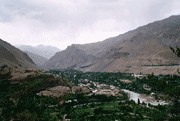 |
Khorog
(view from the botanical gardens)
|
Khorog cannot boast of ancient monuments because it was founded relatively recently (though, there was the ancient capital of Shugnan situated not far from the city). And one of the modern sights of the town is the botanical gardens that I heard a lot about before our journey. These gardens were said to be the second highest in the world, where one can see trees and bushes brought from different parts of the globe. But, frankly speaking, I never considered myself a tree-and-flower-fancier, so I would have never made up my mind to go there. Moreover, this sight is located at a distance from the town center (about an hour walking on foot), and at a pretty big height. But, as Musades told, we had to get there without fail. I was persuaded by the fact that everything caught by my eyes there could be picked and eaten. And my eyes caught a lot: apricots, mulberries, apples, raspberries, cherries, sweet cherries and a lot of other not less delicious fruit of earth. On the whole, the most important conclusion after visiting the botanical gardens was that we would not die of famine there. Moreover, thanks to the local people’s kindness, we got to the gardens not in an official way, but by a roundabout path shown to us by a good woman. That let us economize 3 somons (almost a dollar).
The evening was celebrated by my cooking the most high-level French meat, which received only positive appreciations by citizens of various countries who gathered at Andre’s. It was the most exciting for the Frenchman Wakhib who told us that despite the dish bore a very slight resemblance with the French cuisine (indeed, they prepare something of the kind, also in the oven, but they use mashed potatoes, beef and cheese) he liked it any way.
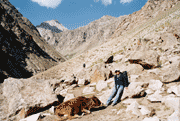 |
Ascending begins |
Next day the early morning our group consisting of three people set off for the exit of Khorog where we took a taxi to kishlak Khidorjiv, which is located near the place where the Khidorjivdara river flows into the Shokhdara.
This part of the Wakhan Range is sometimes called the Shokhdara range thanks to the nearest river. Within two or maximum three days we had to ascend from Khidorjiv which was situated at a height of 2300 meters, along the valley of the Khidorjivdara river, to some lake located at the foot of the peak Nishusp. Then, after crossing the pass not lower than 4200 meters, we had to descend from it by a theoretically existing path to the valley of the Nishusp river, reaching the very place where it was flowing into Pyandj. We were not sure that our route had ever been used by other tourists, and that made it more interesting, even though Wakhib noted that he was indifferent whether we would be first-passers or not.
So, going through the kishlak, and always refusing invitations to have some tea we went to a path running along the Khidorjivdara and began our ascending. Warm and sunny weather made us optimistic at first and improved our mood. We managed to leave on the right the Parshed peak and went on ascending higher and higher.
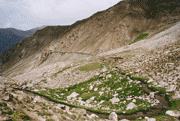 |
Irrigation methods |
I should never have thought that it would be necessary to construct irrigation systems in a mountainous area, taking into account its high humidity which is inherent there, as a rule. Nevertheless, at a height of more than two thousand meters in Badakhshan I could observe original canals laid out with stones, carrying water from the height of four thousand meters and more to the villages below. The gist of these constructions, in my opinion, that such canals come up to the village at a higher level than the river itself which usually goes to the gorge and is therefore less accessible. But the water from the canal is distributed among the aryks and creates almost normal water-supply network which constantly provides the village with fresh running water and irrigates few fields.
The weather was gradually becoming worse. There was cold wind, then the rain, and hail after a while. This all resembled me the events of the last year in the Eastern Tien-Shan mountains when my friend and I got into the snowstorm and had to look for a shelter at the local people. Then at the most crucial moment we ran against a Kazakh aul. Now, fortunately, it did not end with the snowfall, because in some time we were able to reach shepherds’ summer camp (letovka) that was marked on the map and that we were told about by the shepherds we met on our way.
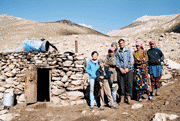 |
Pamiri shepherds’
summer camp |
The Pamiris, seeing our ‘frozen’ condition, quickly boiled milk and prepared famous ‘shirchai’ for us. This kind of drink is popular with other peoples of Central Asia . This is how it must be prepared: they brew strong black tea in water, this mixture is boiled for a long time; and then they put there salt, butter and milk. This drink is very warming, especially in wet mountain conditions, and its nutritive value can substitute meals. Mountain-dwellers often put pieces of bread into piala with this tea and eat this mixture.
We did not want to cramp the dwellers of the shepherds’ camp who were numerous even without us for not full six square meters of the living space, so we asked them where it would be better to pitch a tent. The men went to show us a place, and the women went on boiling tea with milk to give it to frozen Lena to drink.
 |
A young dweller of the Pamirs |
Having put up our tents we fell asleep though it was very early (about five or six in the evening). We woke up only next morning and did not even hear the hospitable Pamiri hosts invite us for dinner (I knew about it the following day).
In the morning Wakhib said that a bit of his tooth had been broken off again (I should note that according to his stories problems with his teeth pursued him during his entire journey: he was at the dentist’s in Dushanbe and Bishkek). Now he was longing to get to Khorog as soon as possible, to go to Dushanbe from there. In Dushanbe, in his opinion, was the nearest civilized dentistry. Thus, his plans about Yashilkul were postponed for indefinite time.
Having said good-bye to the dwellers of the shepherds’ camp and taken a picture at parting (I must say that the Pamiri people like being photographed very much and consider it an honor and therefore are always grateful to the photographer), we set out on our journey. We had to ascend from 3750 meters to the supposed 4200 (but it turned out to be even higher).
I heard a lot about the riches kept by these mountains. Even the name ‘Badakhshan’ is considered to be modified from ‘Balasian’. According to Marco Polo, ‘balas’ was the name for Badakhshan lal, the stone often confused with the ruby in ancient times. Now it is called spinel. By the way, the famous ruby of the Black Prince on the British crown was in actual fact a spinel. Later I often met pink impregnations on the stones (especially in the Wakhan valley), and I suppose them to have been either rose quartz or real spinel. There is also ruby in Badakhshan. For example, in the Bodomdara valley, southwards of the place where we crossed the Wakhan range, there is an abandoned ruby-mine. Both Badakhshans (Tajik and Afghan) are famous for their lapis lazuli, for they are among those few places on earth where one can find this beautiful sky-blue gem (two other deposits known to geologists are in Chile and near Baikal).
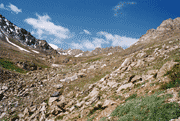 |
Ascending the Avalon-1 Pass |
But now, ascending the pass, I more often saw pieces of the rock shining with metallic luster in the sun. When I observed them in detail, I seemed to have real ‘gold-rush’. Of course, I could suppose that it was just a piece of some quite plain ironstone or copper ore, but I wanted very much to believe that the Pamirs is the place where a man can still find his Klondike.
The last hundreds of meters to the pass were a real torture for Lena. I was very exhausted, too. That is why we moved rather slowly. Finally, moving with frequent stops, we reached the col covered with snow. The satellite navigator indicated 4310 meters above sea level. From the nameless peak you could distinctly see remote mountain ranges of Hindu Kush on the Afghan side of Pyandj, and Sheva Lake famous for its beauty, lying southwards from the Lalmishash mountains. The other side of the pass viewed the snow-white peak Nishusp. The most disappointing was the fact that the lake which was situated at the foot of the peak and was one of the reasons for us to have chosen that route, looked like a small dirty puddle, and not like a turquoise pond as I thought before.
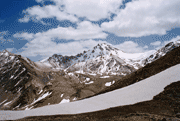 |
Nishusp Peak |
The cold wind blowing through the pass, reminded us that it was high time we descended. Moreover, before the day ended we had to cover a fair distance, and we did not know what route to choose as no path had been marked on the map (as it turned out later, there had never been any paths there). After a short break we began our descent.
The descent from the pass seemed to be endless. Our legs shook and slid apart when we were treading unsafe stones, our breath bated, our heads thinking of the consequences of the possible fall. No slightest hint of a path could be seen. Actually, we found something resembling a path only the next morning, but before that for the rest of the day we had to walk along dangerous slide-rocks or jump from one bank to another or walk in the very river-bed. Naturally, the speed of our moving was not very high.
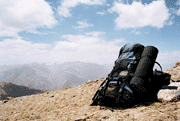 |
Hindu Kush, RedFox |
At about five in the evening we stopped to have a rest a bit. After eating and drinking we dragged down again. Wakhib was hurrying to get to the civilized world as soon as possible, that is why he walked faster than we did. So, it turned out that finally we lagged a pretty distance behind him and in a few hours we understood we would not get to Nishusp before dark. Satellite navigator foretold us that the sun would set in an hour and a half, but we were still at a height of about three thousand meters. Thus, we had to abandon the hope to sleep in Khorog that night for it meant that we would have to descend the whole eight hundred meters within the time remaining. We hardly found a place for the tent in a narrow gorge and stayed overnight there.
The next morning, relaxed and settled down, we walked cheerfully to the Pyandj in a few hours. Here, in Nishusp, I saw Afghanistan at a close distance for the first time. The mountains and kishlaks looked almost the same, and only the road might be a bit worse, but still it was quite a different country we had not happened to get at that time. Having walked onto the road going along the very border near the bank of the Pyandj we stopped to catch a car.
Any car in Badakhshan (even if it is only old ‘Moskvich 412’ ) becomes a microbus. Two passengers on the front sit and four people in the back are literally a necessary minimum. But if there is a strong need, people can squeeze together for everyone needs to go. This time was not an exception, and the passengers grouped together to sit very compact, and as a result we were in Khorog in an hour.
When we finally got at home, on the bed there was a note saying that Wakhib had to go to Dushanbe as soon as possible in order to save his broken tooth. ‘No matter’, we thought, ‘acquaintances are not accidental when you are traveling, and if it is necessary, the fate will make us run into him again’.
|



